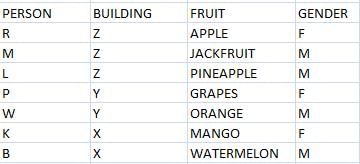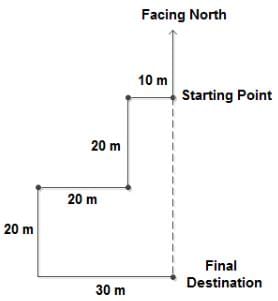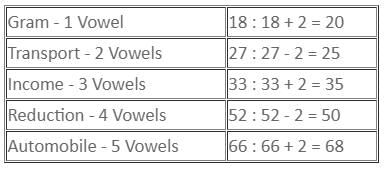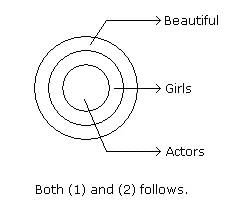SSC CGL (Tier II) Practice Test - 12 - SSC CGL MCQ
30 Questions MCQ Test - SSC CGL (Tier II) Practice Test - 12
(Q1-Q5) Directions to solve:
The bar graph given below shows the sales of books (in thousand number) from six branches of a publishing company during two consecutive years 2000 and 2001.
Sales of Books (in thousand numbers) from Six Branches - B1, B2, B3, B4, B5 and B6 of a publishing Company in 2000 and 2001.
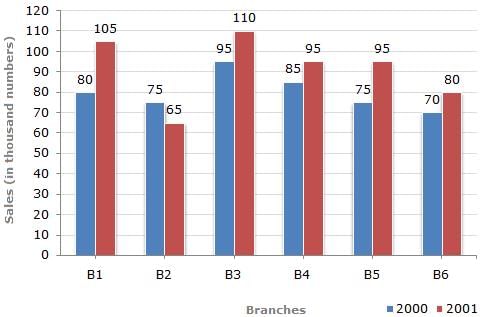
Q. What is the ratio of the total sales of branch B2 for both years to the total sales of branch B4 for both years?
Sales of Books (in thousand numbers) from Six Branches - B1, B2, B3, B4, B5 and B6 of a publishing Company in 2000 and 2001.

Q. What is the ratio of the total sales of branch B2 for both years to the total sales of branch B4 for both years?
Statements :
I. A and D are heavier than B, E and F but none of them is the heaviest.
II. A is heavier than D but lighter than C.
Q. Among A, B, C, D, E and F, who is the heaviest ?
I. A and D are heavier than B, E and F but none of them is the heaviest.
II. A is heavier than D but lighter than C.
Directions: Study the following information carefully and answer the questions given below:
1) Seven friends R, M, K, P, L, W, and B live in three different buildings, i.e. X, Y, and Z. Not less than two or more than three live in any of the buildings.
2) Each of them has a liking for different fruits among apple, jackfruit, watermelon, orange, grapes, pineapple, and mango, not necessarily in that order.
3) Three among them are girls, one each every building. W likes orange and stays in building Y with P only. M lives in building Z and he likes jackfruit.
4) None in building X likes apple or grapes.
5) R and L do not stay in building X.
6) K is R’s close friend and she does not like watermelon. L likes pineapple.
7) None of the girls like orange and one of them likes apple. R does not like grapes.
Q. Which are the three girls?
Directions: In this question below is given a statement followed by two assumptions numbered I and II. Consider the statement and decide which of the given assumptions is implicit.
Statement:
One should make notes from the newspaper everyday for an efficient preparation of current affairs.
Assumptions:
I. One cannot prepare for current affairs efficiently without reading newspapers.
II. Making notes helps in an efficient preparation of current affairs.
Directions: In this question below is given a statement followed by two assumptions numbered I and II. Consider the statement and decide which of the given assumptions is implicit.
Statement:
Today’s generation has forgotten their family values.
Assumptions:
I. The previous generation(s) had their family values intact.
II. The definition of family values changes from generation to generation.
Anjali is facing north. She turns left and walks 10 m. She turns left again and walks 20 m. Then, she turns right and walks 20 m and then again she turns left and walks another 20 m. Finally, she turns left again and walks 30 m.
In which direction is she now from the starting point?
Directions: The given question is on the basis of following information.
A number and word arrangement machine, when given an input line of words and numbers, re-arranges them by undertaking a specific rule in every step. Given below is the illustration of an input and its steps of re-arrangement.
Input: 58 Education 42 Rid 17 Mountain Cinema 23 Complex 6
Step I - Rid 58 Education 42 17 Mountain Cinema 23 Complex 6
Step II - Rid 8 58 Education 42 17 Mountain Cinema 23 Complex
Step III - Rid 8 Complex 58 Education 42 17 Mountain Cinema 23
Step IV - Rid 8 Complex 15 58 Education 42 Mountain Cinema 23
Step V - Rid 8 Complex 15 Cinema 58 Education 42 Mountain 23
Step VI - Rid 8 Complex 15 Cinema 25 58 Education 42 Mountain
Step VII - Rid 8 Complex 15 Cinema 25 Mountain 58 Education 42
Step VIII - Rid 8 Complex 15 Cinema 25 Mountain 40 58 Education
Step IX - Rid 8 Complex 15 Cinema 25 Mountain 40 Education 58
Step X - Rid 8 Complex 15 Cinema 25 Mountain 40 Education 60
Here, step X is the final step of the given input.
Input for the question is given below.
Input: 66 Automobile 52 Gram 27 Reduction Income 33 Transport 18
Q. Which of the following will be the third step of the given input?
Statements:
All the actors are girls.
All the girls are beautiful.
Conclusions:
1. All the actors are beautiful.
2. Some girls are actors.
In the following question, assuming the given statements to be true, find which of the following among the given conclusions is/are definitely true and then give your answers accordingly.
Statement:
S = U > K > L ≥ Y < R ≤ B
Conclusion:
I. K < Y
II. L > Y
III. L = Y
Directions: Read the passage and answer the question given below. Some words are printed in underline in order to help you locate them while answering some of the question.
Member nations of the United Nations body charged with regulating shipping on the high seas adopted a first-ever strategy to blunt the sector’s large contribution to climate change bringing another major constituency on board in the international quest to cap the planet’s warming well below an increase of 2 degrees Celsius (3.6 degrees Fahrenheit). The strategy embraced by a committee of the International Maritime Organization would lower emissions from container ships, oil tankers, bulk carriers and other vessels by at least 50 percent by the year 2050 vs. where they stood in 2008. The group also said that emissions from shipping should reach a peak, and begin to decline, as soon as possible.
But the United States “reserved” its position on the strategy, with Coast Guard official Jeffrey Lantz, who headed the delegation to the London deliberations, saying that the country views “the establishment of an absolute reduction target as premature.” The United States also objected to how responsibilities would be divided between developed and developing countries, and expressed “serious concern about how this document was developed and finalized.” Shipping in recent years has been responsible for about 800 million tons annually of carbon dioxide emissions, according to Dan Rutherford, the marine and aviation program director of the International Council on Clean Transportation, who was in attendance for the deliberations in London. That means shipping’s emissions are 2.3 percent of the global total. “If you counted it as a country, it would be the sixth-largest source of CO2 emissions,” said Rutherford, noting that 800 million tons of annual emissions is comparable to emissions from Germany.
Moreover, if nothing is done to halt emissions growth in the industry, emissions are projected to continue to grow, and shipping would burn up a significant share of the remaining global carbon emissions allowable under the Paris climate agreement releasing as much as 101 billion tons of carbon-dioxide-equivalent emissions between now and 2075, according to an analysis by Rutherford’s organization. Shipping and aviation are two major greenhouse-gas-producing sectors that have sat rather uncomfortably in the context of the global push to cut emissions under the Paris climate agreement.
Both sectors are very difficult to decarbonize, since they rely on energy-dense fuels to allow ships or planes to travel great distances without stopping. Meanwhile, since the sectors have major international components, they are not the responsibility of any single country to regulate as part of a domestic climate-change strategy. Instead, addressing their role in climate change has fallen to United Nations bodies such as the IMO and the International Civil Aviation Organization. Yet despite the ambition of the current strategy for shipping, Rutherford’s group’s analysis shows that it may not be strong enough. The group says that to be consistent with the Paris agreement, shipping should emit no more than 17 billion tons of carbon-dioxide-equivalent emissions from 2015 onward but that the current agreement implies emissions between 28 billion and 43 billion tons.
The group says that to be consistent with the Paris agreement, shipping should emit no more than 17 billion tons of carbon-dioxide-equivalent emissions from 2015 onward but that the current agreement implies emissions between 28 billion and 43 billion tons. For shipping and aviation to decarbonize, current fuel oils would have to be replaced by biofuels or, perhaps ultimately, hydrogen or batteries. But such innovations so far are being tested only in smaller ships and planes. Rutherford said.“The largest container ships and airplanes use a tremendous amount of energy. They’re going to be harder to electrify or put hydrogen in,” he said.
Q. Which out of the following can be inferred from the passage?
According to the Bible / it is meek and humble / who shall inherit the earth / No error.
Find the word most appropriate for Blank no. 15
The (11)____ citizen who has to get everyday jobs done by various municipal and government departments is (12)____ driven up a tree, first (13)____ them, second explaining to them what is (14)____ and lastly, getting the job done.
If this week I (15)____ some personal experience in this column, it is because I can document them. It is not to ask for any special (16)____ or voice personal (17)____ but to bring into public view the experience of hundreds, if not thousands of citizens everyday of the year and express the collective (18)____ of all of them. Because one’s usual experience is that when such complaints are (19)____ in such columns, the departments rush to (20)____
Find the word most appropriate for Blank no. 20
The (11)____ citizen who has to get everyday jobs done by various municipal and government departments is (12)____ driven up a tree, first (13)____ them, second explaining to them what is (14)____ and lastly, getting the job done.
If this week I (15)____ some personal experience in this column, it is because I can document them. It is not to ask for any special (16)____ or voice personal (17)____ but to bring into public view the experience of hundreds, if not thousands of citizens everyday of the year and express the collective (18)____ of all of them. Because one’s usual experience is that when such complaints are (19)____ in such columns, the departments rush to (20)____
Find the word most appropriate for Blank no. 29
Our study about women’s place in Indian society is mainly based on urban, professional and educated Indian women. Deep in the rural heartland of the country, the rapidly changing world has not even touched the (29)____ of the life of a women. Most men of orthodox families take (30)____ in revealing that their (31)____ folk stay in ‘purdah’, a shield that (32)____ a woman of the joys of free nature. Still more alarming are the (33)____ of atrocities of women (34)____ incidents at Bantala, Singur and Birati are (35)____
DIRECTIONS: The following question contains an idiom and its usage in a sentence, followed by five possible meanings labelled A, B, C, D and E. Pick out the right meaning of the idiom in question and mark your answer accordingly.
Q.
Ride rough shod.
Do not "ride rough shod" over the poor.
Directions: Read the following passage carefully and answer the questions given beside.
Remote sensing and GIS are promising tools for handling spatial and temporal data and help in integrating them for successful planning of natural resources. It is the science of measuring the earth using sensors mounted on high-flying aircrafts or satellites. These sensors collect data in the form of images and provide insights for manipulating, analysing and visualising those images. Since natural resources are not uniformly distributed and are spatially varied, it is challenging to capture the correct picture. Management of natural resources calls for scientific tools for timely and accurate dissemination of information. In natural resource management, remote sensing and GIS are mainly used in the mapping process. These techniques are useful in management of land, soil, coastal, watershed, urban and many more.
In India, the agriculture sector alone sustains the livelihood of around 50 percent of the population. Therefore, an increase in crop productivity has been a major concern. Since, the scope for increasing area under agriculture is limited, advanced crop production forecasting is required for better policymaking. Indian Space Research Agency (ISRO) and Indian Council of Agricultural Research (ICAR) successful experiment-Agricultural Resource Inventory and Survey Experiment (ARISE) used aerial colour photographs to estimate crop acreage in many states of India. Other Important uses of remote sensing include crop identification, stress detection, and crop yield modelling, drought monitoring, land degradation mapping and more. Urbanisation is important and inevitable for development, but its proper planning and management is crucial for sustenance. One of the important features of GIS is multilayered mapping. This kind of mapping helps municipal corporations, town planning boards to build cities that are better organised. The information systems with socio-economic data overlaid upon satellite data makes urban planning cost-effective and accurate.
Coastal ecosystems have high ecological significance. GIS and remote sensing data are used to study coastal ecosystems and marine living resources which include habitats like mangroves, coral reefs and more. Apart from this, suspended shoreline dynamics can be studied and climatic changes leading to cyclones and sea level rise may be of special interest too. Geospatial data is effective in the analysis and determination of factors that affect the utilisation of these resources. The technologies provide a platform through which we can generate information that can be used to make sound decisions for sustainable development of the natural resources of India.
Q. How effective are remote sensing and GIS in managing urban growth?
I. GIS and remote sensing are helpful in building cities that are better organized.
II. The system makes urban planning cost-effective and accurate.
III. They help the government disseminate people living in extremely densed areas to less populated ones.
Directions: In the given statements, a blank has been given. This needs to be filled up using the correct combination of words from the three options mentioned, so that the resulting statement is grammatically and contextually correct.
You should not _______________ the streets with rubbish; you should treat the public space the same way you would treat your own home.
I. garbage
II. loiter
III. litter
Directions: In the given statements, a blank has been given. This needs to be filled up using the correct combination of words from the three options mentioned, so that the resulting statement is grammatically and contextually correct.
In the ancient times, remaining alone was dangerous as _______________ animals could easily attack its solitary prey.
I. domesticated
II. wild
III. herbivorous
Directions: Read the following passage carefully and answer the questions given beside.
Remote sensing and GIS are promising tools for handling spatial and temporal data and help in integrating them for successful planning of natural resources. It is the science of measuring the earth using sensors mounted on high-flying aircrafts or satellites. These sensors collect data in the form of images and provide insights for manipulating, analysing and visualising those images. Since natural resources are not uniformly distributed and are spatially varied, it is challenging to capture the correct picture. Management of natural resources calls for scientific tools for timely and accurate dissemination of information. In natural resource management, remote sensing and GIS are mainly used in the mapping process. These techniques are useful in management of land, soil, coastal, watershed, urban and many more.
In India, the agriculture sector alone sustains the livelihood of around 50 percent of the population. Therefore, an increase in crop productivity has been a major concern. Since, the scope for increasing area under agriculture is limited, advanced crop production forecasting is required for better policymaking. Indian Space Research Agency (ISRO) and Indian Council of Agricultural Research (ICAR) successful experiment-Agricultural Resource Inventory and Survey Experiment (ARISE) used aerial colour photographs to estimate crop acreage in many states of India. Other Important uses of remote sensing include crop identification, stress detection, and crop yield modelling, drought monitoring, land degradation mapping and more. Urbanisation is important and inevitable for development, but its proper planning and management is crucial for sustenance. One of the important features of GIS is multilayered mapping. This kind of mapping helps municipal corporations, town planning boards to build cities that are better organised. The information systems with socio-economic data overlaid upon satellite data makes urban planning cost-effective and accurate.
Coastal ecosystems have high ecological significance. GIS and remote sensing data are used to study coastal ecosystems and marine living resources which include habitats like mangroves, coral reefs and more. Apart from this, suspended shoreline dynamics can be studied and climatic changes leading to cyclones and sea level rise may be of special interest too. Geospatial data is effective in the analysis and determination of factors that affect the utilisation of these resources. The technologies provide a platform through which we can generate information that can be used to make sound decisions for sustainable development of the natural resources of India.
Q. In the given context of the passage, why are GIS and remote sensing tools crucial in the agriculture sector?
I. This sector alone sustains the livelihood of around 50 percent of the population.
II. GIS and remote sensing would help in advanced crop production forecasting.
III. Drought monitoring can be done using GIS and remote sensing tools.
Direction: The sentences given in the question, when properly sequenced, form a coherent paragraph. Each sentence is labeled with a letter. Choose the most logical order of sentences from the given choices to construct a coherent paragraph.
A. What Darwin discovered on the Galapagos Isles was not the idea that species evolved, or even a possible model for how that evolution might have taken place.
B. His ability to see this fact, and exploit it so brilliantly, is why we remember Charles Darwin today.
C. Darwin ultimately owes the near-instant success of his theory to the fact that the islands of the Galapagos made such perfect petri dishes for generating that evidence.
D. Rather, what he found was a naturally occurring laboratory, one exquisitely shaped to allow the study of speciation and to make his model the first supported by real evidence.
Directions: Read the following passage carefully and answer the questions given beside.
A powerful cyclonic storm named Fani (pronounced Foni) is headed towards the Odisha coast, with its landfall forecast near Puri Friday. Expected to generate storms with wind speeds as high as 200 km per hour, it has the potential to cause widespread damage in Odisha and neighbouring states. The last time such a powerful cyclonic storm had emerged in the Bay of Bengal at this time of the year, in 2008, it had killed more than 1.25 lakh people in Myanmar. But that was mainly because of the lack of a sophisticated warning system and enough logistical preparedness to evacuate people.
Fani, on the other hand, has been continuously monitored ever since it developed in the southeast of Sri Lanka about a week ago, warnings have been issued after every few hours to fishermen and people living in coastal regions, and a massive emergency preparedness has been mounted. In the last few years, India has impressively managed disasters caused by cyclones, most remarkably during Cyclone Phailin of 2013, which was even stronger than the approaching Fani.
The eastern coast of India is no stranger to cyclones. On an average, five to six significant cyclonic storms emerge in the Bay of Bengal region every year. The months of April and May just before the start of the monsoon, and then October to December immediately after the end of the monsoon, are the prime seasons for tropical cyclones.
Q. Which of the following places is termed as the birth place of most of the cyclonic storms?
Which football hero was nicknamed "The Sundance Kid"?
Who among the following was associated with the Mughal Court as a physician to Prince Dara Shikoh?
The Reserve Bank of India has decided to help banks as a temporary measure, by providing additional liquidity support under LAF. What does LAF stand for?
___________ is an emerging branch in computer science, which interprets means and method of making computers think like human beings.
Primary memory is computer memory that a processor or computer accesses first or directly. It allows a processor to access running execution applications and services that are temporarily stored in a specific memory location. What is the other name of Primary Memory?
Which of the following formats does the database management system store data in?
The term _______ designates equipment that might be added to a computer system to enhance its functionality.




